Over the past several decades, advancements in agriculture have transformed farming practices. Innovations have significantly boosted productivity, with corn and soybean yields doubling in the Seventh Federal Reserve District over the last 55 years. Despite these gains, real prices for these crops have fallen by 50% since the 1970s, creating a paradox for many producers.
While tools like robotics and AI have streamlined production, net farm income has declined since 2013. This highlights the complex relationship between technological development and economic outcomes. Precision agriculture has brought efficiency, but its benefits haven’t always translated into financial stability for farmers.
Research from the Federal Reserve reveals that broadband access offers a $4:$1 return on investment for rural economies. However, the USDA warns that reduced funding for research could slow future productivity growth. As agriculture continues to evolve, balancing innovation with economic sustainability remains a critical challenge.
For more insights on the impact of AI in agriculture, explore how these tools are shaping the future of farming.
Introduction: The Evolution of Farming Through Technology
The farming landscape has undergone significant changes over the years. With the global population projected to reach 9.7 billion by 2050, the demand for food has placed immense pressure on the agriculture industry. This has driven the need for innovative practices to meet growing requirements efficiently.
Investments in technology have played a pivotal role in this transformation. The World Bank has allocated $6.7 billion to 157 agtech projects, benefiting 9.7 million farmers worldwide. These initiatives have introduced advanced tools and methods, enabling producers to enhance their operations and improve yields.
Since the 1980s, crop production has increased sixfold, thanks to precision management techniques. This remarkable growth highlights the potential of innovation in addressing global food challenges. However, the rise in productivity has also coincided with a decline in rural populations, creating a complex dynamic for the industry.
According to USDA findings, agricultural output has tripled since 1950, while input levels have remained flat. This underscores the efficiency gains achieved through development in farming methods. As the sector continues to evolve, balancing these advancements with economic and social sustainability remains a critical focus.
The Historical Context of Agricultural Technology
The journey of farming has been shaped by groundbreaking innovations. Over the years, advancements in agriculture have transformed the way farmers work. From simple tools to complex systems, each step has left a lasting impact.
Between 1950 and 2015, U.S. agricultural output tripled while input levels remained flat. This remarkable achievement was driven by improved methods and research. The USDA’s analysis highlights the efficiency gains achieved through these advancements.
Early Innovations in Farming
Early farming relied on manual labor and basic tools. For example, hand milking was common from 1880 to 1920. Today, robotic dairy systems have revolutionized the process. These changes reflect the ongoing evolution of technology in agriculture.
Hybrid seeds, introduced during the Green Revolution, increased corn yields by 20%. This innovation marked a turning point in crop production. Farmers quickly adopted these seeds, leading to significant improvements in productivity.
The Role of the Green Revolution
The Green Revolution brought major changes to farming practices. It introduced high-yield crops and advanced methods for soil management. These developments helped address food shortages and boosted global agricultural output.
However, public research funding peaked in 2001 and declined by 20% afterward. This reduction has slowed productivity growth in recent years. According to Fuglie’s analysis, public ag research offers a $10:$1 return on investment, underscoring its importance.
As programs and innovation continue to shape farming, the lessons from history remain crucial. Balancing progress with sustainability is key to the future of agriculture.
How Did New Technology Both Help and Hurt the Farmers?
The integration of cutting-edge systems has transformed crop and livestock management. These advancements have brought significant improvements in productivity and efficiency, but they also present economic hurdles for many producers.
Boosting Productivity and Efficiency
Modern tools have revolutionized farming practices. Corteva’s seed treatments, for example, have increased yields by 15-20% in trials. Similarly, robotic milking systems have boosted milk production by 3-5% on dairy farms.
These innovations allow farmers to manage their resources more effectively. Precision equipment enables better monitoring of soil and crop conditions, leading to higher quality outputs. However, the high costs of these systems can be a barrier for smaller operations.
Economic Challenges of Adoption
While the benefits are clear, the financial impact of adopting advanced technology is significant. Robotic milking systems, for instance, can cost up to $250,000, making them inaccessible for many farmers.
Broadband availability also plays a crucial role. In 2016, only 69% of rural areas had access, compared to 98% in urban regions. This disparity limits the adoption of precision systems that rely on real-time data.
Additionally, consolidation trends have reduced the number of mixed crop-livestock farms by 75%. This shift highlights the growing divide between large-scale operations and smaller producers.
Fiber optic solutions are emerging to address latency issues, enabling faster access to commodity pricing. However, these advancements require substantial investment, further complicating the economic landscape for farmers.
The Role of Precision Agriculture
Precision agriculture has reshaped modern farming practices. By integrating advanced tools and data-driven methods, producers can optimize productivity and resource management. This approach focuses on using technologies to monitor and analyze soil, water, and crop conditions in real time.
Benefits of Precision Agriculture
One of the key advantages is improved efficiency. For example, spectral imaging has reduced fertilizer use by 20% in Purdue trials. This technology also detects pests with high accuracy, minimizing crop damage.
Automated irrigation systems have shown significant results, saving 30% of water usage in drought-prone areas. Soil moisture sensors provide precise data, ensuring crops receive the right amount of water at the right time.
- Spectral imaging enhances pest detection and reduces chemical use.
- Automated irrigation systems conserve water and improve yields.
- Soil sensors offer real-time analysis for better decision-making.
Challenges in Implementing Precision Agriculture
Despite its benefits, adoption faces hurdles. In Indiana, 45% of farms lack adequate broadband for drone data analytics. This limits the use of advanced technologies that rely on real-time information.
Infrastructure costs are another barrier. Fiber optic solutions, like those by Shawnee Communications, have shown success but require significant investment. The FCC’s 100/sq mi density threshold for infrastructure ROI further complicates expansion in rural areas.
- Broadband limitations hinder the use of precision tools.
- High costs of infrastructure deter smaller operations.
- Regulatory thresholds slow the rollout of essential programs.
Balancing these challenges with the potential of precision agriculture remains critical for the future of farming. Continued research and investment are essential to bridge the gap and ensure widespread adoption.
Technological Advancements in Livestock Farming
Modern livestock farming has seen remarkable progress through innovation. These advancements have improved health, quality, and overall efficiency in animal husbandry. From genetic improvements to automated systems, the sector continues to evolve.
Genetic Improvements in Livestock
Genetic advancements have transformed livestock operations. Embryo transfer, for example, boosts dairy herd productivity by 30%. This method ensures higher success rates compared to traditional artificial insemination.
Genomic selection has also enhanced meat quality. By analyzing DNA, producers can predict traits like marbling scores, leading to better market value. These innovations are backed by extensive research, ensuring reliable results.
Automation in Livestock Management
Automated equipment has streamlined daily tasks. Robotic milkers achieve 99% consistency, outperforming the 92% average of manual milking. This reduces labor costs and improves health monitoring for dairy cows.
Automated feeders have also made a significant impact. According to UW-Madison data, they reduce feed waste by 18%. Temperature-controlled barns further enhance health by preventing diseases, ensuring optimal conditions for livestock.
These systems not only save time but also improve overall quality and efficiency. As the industry continues to adopt these tools, the future of livestock farming looks promising.
The Impact of Technology on Farm Labor
The rise of advanced tools has reshaped the workforce in agriculture. Over the past decades, technology has streamlined operations, reducing the need for manual labor. According to the USDA, agricultural jobs have declined by 40% since 1950. This shift reflects the growing reliance on automation and precision systems.
Reduced Labor Requirements
Automation has transformed traditional farming tasks. Tasks like milking, planting, and harvesting are now handled by robotic systems. For example, robotic milkers achieve 99% consistency, outperforming manual methods. This efficiency reduces the demand for low-skill workers but increases the need for technical expertise.
CoBank’s data-driven lending models highlight the economic impact of these changes. While larger farms benefit from cost savings, smaller operations face challenges in adopting expensive technology. This disparity underscores the need for accessible solutions in the industry.
The Shift in Labor Skills
Modern farming now requires a different set of skills. A study shows that 78% of dairy farms need workers with coding and robotics knowledge. This contrasts sharply with traditional husbandry roles, which focused on hands-on animal care.
Vocational training programs are addressing this gap. Between 2010 and 2020, agricultural STEM degrees increased by 22%. This trend reflects the growing importance of data analysis and technical proficiency in farming. By 2030, roles like ag data analysts are projected to grow by 30%, signaling a continued shift in labor demands.
For a deeper dive into these trends, explore insights from the Chicago Fed’s analysis on agricultural development.
The Role of Digital Technology in Agriculture
Digital innovations are reshaping the agricultural landscape in profound ways. From artificial intelligence to advanced data analytics, these tools are transforming how farmers manage their operations. The integration of digital systems has enabled more precise decision-making, improving both productivity and sustainability.
AI and Machine Learning in Farming
Artificial intelligence is playing a pivotal role in modern farming. Machine learning algorithms can predict crop yields with remarkable accuracy, often within 2%. These technologies also excel in disease detection, with some algorithms achieving 95% accuracy rates. This allows farmers to take proactive measures, minimizing crop losses.
Edge computing solutions are addressing connectivity challenges in remote areas. By processing data locally, these systems reduce reliance on constant internet access. Cellular IoT sensors are another breakthrough, providing real-time monitoring of soil nitrate levels. This information helps optimize fertilizer use, reducing costs and environmental impact.
The Importance of Broadband Access
Broadband connectivity is essential for the adoption of digital technologies. In rural regions, however, gaps in access remain a significant barrier. A Purdue study estimates that these gaps cost Indiana $12 billion annually. Without reliable internet, farmers cannot fully utilize tools like real-time combine sensor data transmission enabled by 5G.
The USDA’s ReConnect Program is addressing this issue by funding broadband infrastructure in underserved areas. These investments are critical for ensuring that all farmers can benefit from digital advancements. Improved connectivity also supports futures trading by reducing latency in data transmission.
| Technology | Latency | Best Use Case |
|---|---|---|
| Satellite | 500-700 ms | Remote monitoring |
| Fiber Optic | 1-10 ms | Real-time data analysis |
As agriculture continues to embrace digital technologies, the focus must remain on accessibility and affordability. Bridging the digital divide will ensure that all farmers can thrive in this new era of innovation.
Environmental Impacts of Agricultural Technology
Agricultural advancements have brought both progress and environmental concerns. While innovations have improved productivity, they also pose significant challenges to ecosystems. Balancing sustainability with efficiency remains a critical goal for modern farming.
Sustainable Farming Practices
Adopting eco-friendly practices is essential for long-term sustainability. No-till farming, for instance, reduces soil erosion by 90% in Iowa trials. This method preserves soil structure and enhances water retention.
Cover cropping systems also play a vital role. They sequester carbon, improving soil health and reducing greenhouse gas emissions. Solar-powered irrigation systems offer another solution, with payback periods as short as three years in some regions.
- No-till farming minimizes erosion and conserves resources.
- Cover crops enhance carbon sequestration and soil quality.
- Solar irrigation reduces reliance on non-renewable energy sources.
Environmental Challenges
Despite these efforts, challenges persist. Data center energy use for agtech increased by 200% between 2015 and 2020. This rise highlights the hidden environmental costs of digital farming tools.
Precision sensors, while effective, demand rare earth minerals. Their extraction often leads to habitat destruction and pollution. Blockchain applications, though promising for supply chain transparency, require significant energy, adding to the carbon footprint.
| Challenge | Impact | Solution |
|---|---|---|
| Energy Use | Increased carbon emissions | Renewable energy adoption |
| Mineral Demand | Habitat destruction | Recycling and alternative materials |
| Water Runoff | Pollution of water bodies | Nitrogen sensors and precision application |
Addressing these issues requires ongoing research and innovative management strategies. By integrating eco-friendly practices, the agricultural sector can achieve both productivity and sustainability.
The Future of Agricultural Technology
The next decade promises transformative shifts in agricultural practices. From gene editing to vertical farming, technologies are poised to address global food demands. These advancements will shape the future of farming, offering solutions to pressing challenges like climate change and resource scarcity.
Emerging Technologies in Agriculture
CRISPR gene editing is at the forefront of agricultural innovation. By 2035, it could boost crop yields by 50%, particularly for drought-resistant wheat. This development offers hope for regions facing water shortages and extreme weather conditions.
Vertical farming is another promising trend. While it reduces land use, its energy costs remain a paradox. Solar-powered systems are emerging as a solution, balancing efficiency with sustainability. These technologies are reshaping how we think about food production.
- CRISPR editing enhances crop resilience and yield potential.
- Vertical farming maximizes space but requires energy-efficient solutions.
- Solar-powered systems offer a sustainable path forward.
The Role of Policy and Investment
Government programs and private funding are driving agricultural development. The USDA’s $2 billion Partnerships for Climate-Smart Commodities initiative supports eco-friendly practices. Meanwhile, venture capital agtech funding reached $4.6 billion in 2021, fueling innovation across the sector.
Carbon credit trading platforms are gaining traction, offering smallholders new revenue streams. However, disparities in public vs. private sector R&D investment remain a challenge. Bridging this gap is essential for equitable progress.
| Initiative | Impact |
|---|---|
| USDA Climate-Smart Commodities | Promotes sustainable practices |
| Venture Capital Funding | Drives agtech innovation |
| Carbon Credit Platforms | Supports smallholder income |
As these programs evolve, collaboration between policymakers, investors, and farmers will be key. Together, they can ensure that the future of agriculture is both productive and sustainable.
Conclusion: Balancing the Benefits and Challenges of Agricultural Technology
The relationship between agricultural progress and economic outcomes remains complex. While technology has boosted productivity, with 60% of farms now using precision tools, rural populations have declined by 15% since 2000. This paradox highlights the uneven impact of innovation across the sector.
Agricultural exports reached $196 billion in 2022, reflecting the sector’s global competitiveness. However, income stagnation for many farmers underscores the need for balanced development. Hybrid broadband infrastructure funding models could bridge connectivity gaps, enabling wider adoption of advanced systems.
Investing in STEM curricula for agricultural education is essential to prepare the workforce for the future. As research continues to drive technology, its role remains necessary but insufficient alone. Addressing these challenges will ensure sustainable growth for agriculture in the years ahead.














